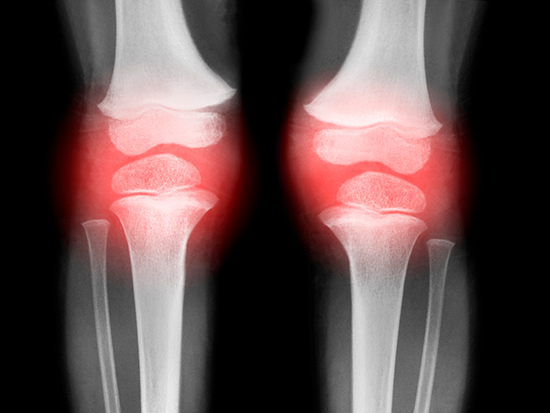University Of Alabama At Birmingham Study Reveals Novel Genetic Loci Association With Osteoarthritis
The first large multi-ancestry genetics study of osteoarthritis, or OA, has found 10 novel OA-associated genetic loci, and results showed some of the OA-associated regions are robustly found in every population ancestry studied. The study also replicated other loci from previous OA studies, and it identified novel ancestry-specific genetic variants associated with OA among African American, Hispanic and Asian American United States military veterans.
The team performed a drug repurposing and found genes expected to contribute to OA included targets for existing drugs against cancer, epilepsy and acne, which may offer clues to etiology and possible treatment of OA. Current physicians have intuitively prescribed anti-epileptic drugs for OA pain, despite gaps in understanding how they work in patients.
These results, published in the journal Nature Genetics, add insight to how the common progressive joint disease OA develops. Currently little is known about causes of the developing disease, and treatment is largely limited to managing pain and inflammation. Because clinicians have no effective intervention to halt or slow OA, it often proceeds to the end stage, requiring total joint replacement surgery.
A better understanding of the genetic influences of OA should help identify targeted personalized approaches to treating patients, long before the end stage is reached, says Merry-Lynn McDonald, Ph.D., who led researchers from the University of Alabama at Birmingham, the Birmingham Veterans Affairs Healthcare System, Birmingham, Alabama, and several other Veterans Affairs Healthcare System sites.
While many previous genome-wide association studies have found genetic loci associated with OA, they predominantly involved people of European white descent. The study led by McDonald in collaboration UAB researchers, including Jasvinder Singh, M.D., Joshua Richman, M.D., Ph.D., and Hemant Tiwari, Ph.D., from UAB, used unique resources of 484,374 participants in the Million Veteran Program of the U.S. Department of Veterans Affairs and the United Kingdom Biobank, two huge biomedical databases containing in-depth genetic and health information. These databases offered some opportunity for ancestry analysis, though they still skewed toward European whites.
The 163,015 OA participants from the Million Veteran Program were 73.2 percent European white, 17.5 percent African American, 0.8 percent Asian American and 6.3 percent Hispanic. The 321,359 OA participants from the U.K. Biobank were 91.4 percent European white, 2.2 percent African, 0.5 percent East Asian and 2.2 percent South Asian.
“Although we performed multi-ancestry and stratified analyses, most subjects in the study were of European white descent,” said McDonald, an associate professor in the UAB Department of Medicine, Division of Pulmonary, Allergy and Critical Care Medicine, and a research health scientist in the Birmingham Veterans Affairs Healthcare System. “There remains a great need for more research to identify genetic variants and regions associated with OA that are robust to ancestry for developing precision medicine approaches generalizable to all patients. Our multi-ancestry genetic association study of OA represents only a step toward closing the gap in the lack of studies investigating the genetics of OA in populations of non-European-white descent.”
OA has a profound health impact. The annual cost of OA on U.S. veterans alone is more than $880 million a year. OA is the most common form of arthritis, often affecting hands, hips, knees, feet and spine, and it is the leading cause of leg disabilities in older adults. Non-genetic risk factors for the disease include aging, being female and being overweight. Yet OA also has genetic risk factors, and its heritability estimates are more than 30 percent.
The novel OA-associated genetic loci give clues to how OA develops. For example, one locus on chromosome 2 is in a gene for the protein fibulin-3. “Fibulins are known to contribute to elasticity and functional integrity of connective tissues,” McDonald said. “Fibulin-3 levels in serum and urine correlate with osteoarthritis disease incidence and progression and can be used as biomarkers.”
Another example is a locus on chromosome 3 in the gene for protein tyrosine phosphatase receptor type G, which has been shown to be hydroxymethylated in tissue that forms cartilage in patients with osteoarthritis. Another example is two independent OA-associated loci on chromosomes 11 and 12 at genes known to regulate the body’s circadian clock, which has been implicated in OA.
Finding OA-associated genes that are also targets of existing drugs for cancer, epilepsy and acne may lead to repurposing those drugs for OA. Current physicians have intuitively prescribed anti-epileptic drugs for OA pain, despite gaps in understanding how they work in patients.
As for cancer and acne drugs, “Many anti-neoplastic agents have anti-fibrotic properties,” McDonald said. “Synovial inflammation and fibrosis mark osteoarthritis progression, supporting the logic that some anti-neoplastic agents may have benefits for osteoarthritis. Anti-acne preparations include azaleic acid, which is decreased in urine in an osteoarthritis rat model.”
McDonald urges follow-ups to this current study. “Multi-ancestry osteoarthritis-associated variants identified in the current report only begin to fill the void in terms of identifying the ancestry-independent osteoarthritis-associated variants needed to advance the development of polygenic risk scores,” she said. “Larger sample sizes of ancestrally and ethnically diverse individuals are needed to continue to fuel progress and remedy discovery bias imposed by previous European white-focused research.”
This work was possible due only to a massive and successful ongoing effort in recruitment of military veterans across the United States, including the Birmingham VA, complemented by cutting-edge data science approaches by the team’s UAB bioinformaticians: Preeti Lakshman Kumar, Ashwathy Nair and Vinodh Srinivasasainagendra. “It was both a daunting and exciting experience to have this phenomenal team execute genetic analyses for more than 400,000 people,” McDonald said.

